
6 bushes for low hedges
Create your small hedge with deciduous or evergreen foliage.
Contents
Creating a low hedge helps to define areas of the garden without obstructing the view. It is therefore generally recommended to choose bushes that are less than one metre high at ripeness and that can withstand pruning well. Thus, these plants can also be planted in small gardens where space is limited. Of course, it is not obligatory to prune them; it all depends on the effect desired by the gardener. In our range, the selection of plants for low hedges is extensive. Whether they are deciduous species or small evergreen bushes, they offer a variety of leaf colours that allow for personalisation of the hedge. Some are flowering, others thorny, or even fragrant and melliferous, but they often bear toxic fruits if ingested, so caution is needed with children to avoid poisoning. We have selected dwarf bushes for you, ideal for edging paths and terraces or structuring beds in full sun or partial shade. Discover our favourite varieties of small-growing bushes without delay!
Dwarf barberries
Barberry or berberis is an excellent bush for hedges with varied appearances. Thanks to its thorns, it is often used to create defensive hedges, but the evergreen or deciduous varieties not exceeding one metre in height and spread can perfectly serve for the display of a low hedge:
Dwarf evergreen barberries
- The Berberis buxifolia ‘Nana’ is also known as box-leaved barberry. At maturity, it forms a bush with rounded dark green leaves about 50 cm in all directions.
- The Berberis darwinii ‘Compacta’ or Darwin barberry ‘Compacta’ has a bushy habit of 90 cm in all directions. Its young red leaves at bud burst turn green afterwards.
- Very similar to the ‘Compacta’ variety, the Darwin barberry ‘Nana’ features repeat flowering in autumn.
Dwarf deciduous barberries
- The Thunberg barberry ‘Concorde’ (Berberis thunbergii ‘Concorde’) is a beautiful variety with purple foliage reaching 60 cm in all directions at maturity.
- The Berberis thunbergii ‘Inspiration’ offers very changing foliage, transitioning from purple splashed with pink and white to solid purple, finishing with red and orange in autumn. It forms a silhouette of 50 cm in all directions.
- The Japanese barberry ‘Tiny Gold’ (or Berberis thunbergii ‘Tiny Gold’) is a dwarf barberry with acid green foliage not exceeding 40 cm in height and spread.
- Compact and upright (70 cm high and 40 cm wide), the Berberis (x) thunbergii ‘Orange Ice’ is striking with its red-orange foliage.
- A little smaller than ‘Orange Ice’, the dwarf barberry Berberis thunbergii ‘Lutin Rouge’ displays remarkable scarlet foliage turning to purple-red.
 Berberis darwinii ‘Nana’ (photo Wikipedia), Berberis thunbergii ‘Concorde’, Berberis thunbergii ‘Tiny Gold’ and Berberis thunbergii ‘Orange Ice'[/caption>
Berberis darwinii ‘Nana’ (photo Wikipedia), Berberis thunbergii ‘Concorde’, Berberis thunbergii ‘Tiny Gold’ and Berberis thunbergii ‘Orange Ice'[/caption>
These varieties offer a colourful spring flowering that gives rise to decorative fruits. Fast-growing, these thorny bushes are easy to grow and tolerate pruning well. Hardy, they can thrive in all types of soil and prefer semi-shaded exposures, possibly full sun for deciduous foliage.
⇒ Find all our growing tips in the plant sheet Berberis, barberry: planting, pruning and maintenance
The crenate holly
Very different from common holly, the crenate holly (Ilex crenata in Latin) does not have spiny leaves. Its foliage is ovate and resembles that of boxwood. With its bushy and highly ramified habit, this evergreen shrub allows for the creation of low, dense hedges that can be pruned to your liking. The Ilex crenata can also be used for topiary or even as bonsai. Here are two interesting evergreen cultivars due to their small size:
- The Ilex crenata ‘Golden Gem’ is much wider than it is tall (90 cm high and 1.20 m wide). Its golden green foliage is very bright.
- About 50 cm high, the dwarf crenate holly ‘Stokes’ tends to spread its branches with uniform green leaves.
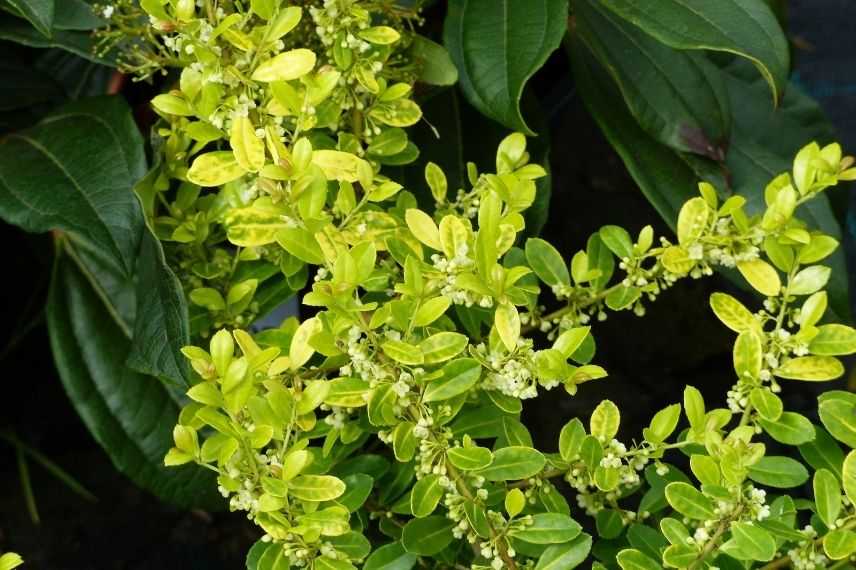
Ilex crenata ‘Golden Gem’
After fertilization, the insignificant flowering of this robust and vigorous shrub produces round, black fruits on female plants. Hardy, the Japanese holly prefers soils rich in humus and light. Golden foliage is more intense in sunlight, while green foliage should preferably be exposed to partial shade.
⇒ Find all our growing tips in the plant sheet Holly: planting, pruning and care
Discover other Low hedges, 1m (3 ft 4 in)
View all →Available in 0 sizes
Available in 1 sizes
Available in 1 sizes
Available in 1 sizes
Available in 1 sizes
Available in 1 sizes
Available in 1 sizes
Available in 1 sizes
Available in 2 sizes
Available in 1 sizes
Euonymus fortunei
The Euonymus fortunei is a particularly compact spindle tree, ideal for use in modest hedges. Tolerant to pruning, the Fortune spindle tree has decorative evergreen foliage throughout the year. Opt for small varieties that you can place in full sun or partial shade. You can leave them in a free habit or train them into a trimmed hedge. Here’s a selection of the most beautiful cultivars:
- The Fortune spindle tree ‘Emerald’n Gold’ boasts stunning variegated foliage of green and yellow, forming a bush 60 cm high and 90 cm wide.
- With a low and creeping habit (30 cm high and 60 cm wide), the Euonymus fortunei ‘Coloratus’ is renowned for its beautiful purple-red autumn colouring.
- The ‘Euonymus fortunei ‘Emerald Gaiety’, variegated with green and white, does not exceed 1 m in height at maturity.
- With a beautiful homogeneous habit (40 cm high and 50 cm wide), the evergreen spindle tree ‘Harlequin’ features original white-speckled foliage.
- Compact (50 cm in all directions), the Fortune spindle tree ‘Goldy’ is adorned with very golden foliage, which slightly greens over time.
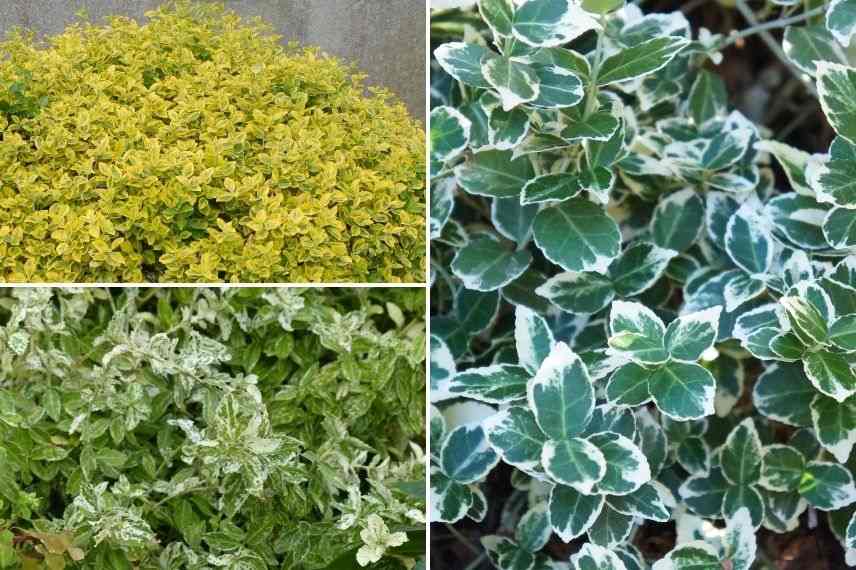
Euonymus fortunei ‘Emerald’n Gold’, Euonymus fortunei ‘Emerald Gaiety’ and Euonymus fortunei ‘Harlequin’
Just like the crenate holly, the flowering of the Fortune spindle tree is not of great aesthetic interest, but it is followed by the production of small capsules containing seeds appreciated by birds. Slow-growing, yet hardy, the Euonymus fortunei withstands cold well, as well as pollution, making it very suitable for urban gardens. Note that it also tolerates sea spray.
⇒ For everything you need to know about growing spindle trees, feel free to consult our dedicated page Spindle, Euonymus: planting, pruning and maintaining
Read also
How to create a Berberis hedge?The common privet ‘Lodense’
The Ligustrum vulgare ‘Lodense’ is a dwarf variety of privet with excellent resistance to repeated pruning as its main asset. While the trimmed hedge is the primary use of this evergreen to semi-evergreen shrub depending on the climate, it is possible to let it grow freely. When untrimmed, the common privet ‘Lodense’ reaches about 80 cm to 1 m in all directions at maturity. If regularly pruned, its branching is stimulated and this small privet can then replace boxwood often used in low hedges. Its narrow, ovate dark green leaves take on a stunning bronze hue in autumn. Its summer flowering is discreet but fragrant. To make the most of it, allow this shrub to develop freely in spring. The small cream-white flowers are nectariferous and pollen-rich, attracting bees, butterflies, and bumblebees to the garden. In autumn, the fruiting occurs in the form of black berries, a source of food for birds. This hardy privet, native to Europe, thrives in ordinary soil and in sunny or partially shaded locations.
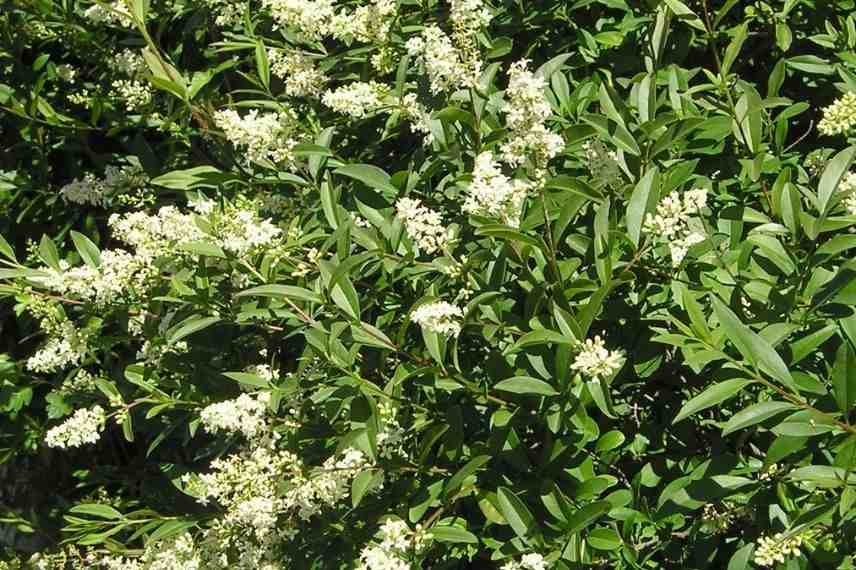
Ligustrum vulgare ‘Lodense’ (photo maja dumat)
To learn everything about cultivating spindle trees, check our dedicated sheet Privet, ligustrum: planting, pruning, and maintaining.
Shrubby cinquefoil
Charming, the bush cinquefoil is suitable for forming low hedges. Although it has deciduous foliage that disappears during winter, it boasts another asset: its generous and vibrant flowering. Pruning is not an issue for this very hardy bush, which also has the advantage of being drought-resistant. For a low hedge, choose a variety with moderate growth such as:
- the Potentilla fruticosa ‘Mango Tango’, which reaches 60 cm in all directions and displays striking orange flowers from May to September
- the Potentilla fruticosa ‘Bellissima’, about 50 cm tall and wide, which produces bright pink flowers from June to September.
- the bush cinquefoil ‘Marian Red Robin’, which showcases cup-shaped flowers in deep red from June to September, forming a bush 75 cm high and 90 cm wide.
- the sweet bush cinquefoil ‘Lovely Pink’, which grows to less than a metre high and is covered in pale pink flowers from May to September, reminiscent of the flowering of the dog rose.
- similarly sized, the Potentilla fruticosa ‘White Lady’ reveals simple white flowers later from June to October.
- very bright, the variety Potentilla fruticosa ‘Citrus Tart’ (80 cm in all directions) lives up to its name: from May to October, it is adorned with bright yellow flowers.
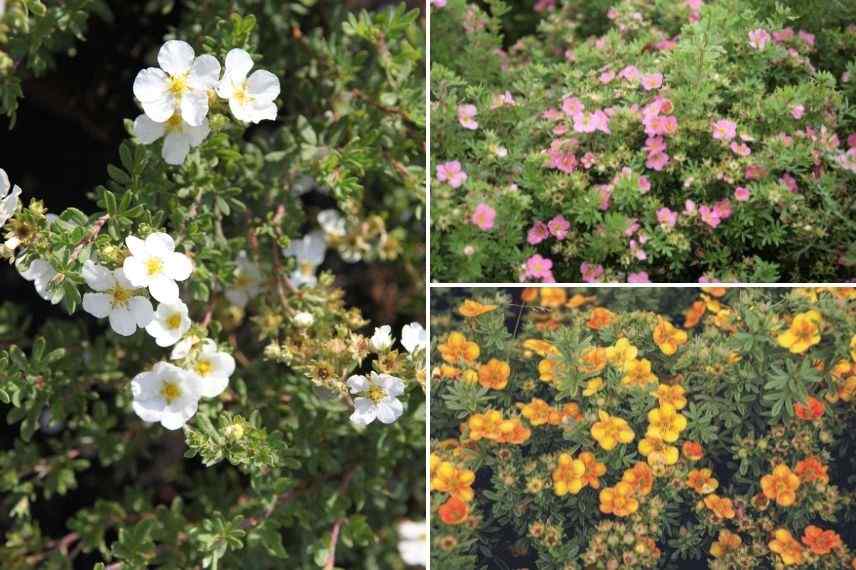
Potentilla fruticosa ‘White Lady’ (photo Denolf), Potentilla fruticosa ‘Lovely Pink’ and Potentilla fruticosa ‘Mango Tango’
Compact shrubs with rapid growth, bush cinquefoils thrive in well-drained, neutral to calcareous, poor, or even stony soils, in sunny or semi-shaded positions.
For more information, check our sheet on Cinquefoil: planting, maintaining, pruning.
Dwarf shrub honeysuckle
Bush honeysuckles are perfect for shaping small hedges and wonderfully replace boxwood borders in French gardens. Unlike climbing honeysuckles, which are primarily valued for their flowering, Lonicera bushes do not produce impressive flowers. These vigorous shrubs are mainly recognised for their dense foliage and their ease of cultivation and maintenance. Here are our favourite evergreen varieties that are well-suited for low hedge formation:
- The Lonicera pileata ‘Mossgren’, also known as cup honeysuckle ‘Mossgren’, has very fresh, glossy olive-green foliage. About 50 cm tall, it spreads wider than the typical species (up to 1.60 m in width).
- Bright and cheerful, the dwarf honeysuckle Lonicera nitida ‘Lemon Beauty’ forms a clump of green foliage variegated with yellow, reaching up to 1 m in all directions.
- Also variegated and of similar size, the box-leaved honeysuckle Lonicera nitida ‘Silver Beauty’ features leaves marginate with white, giving it an elegant appearance.
After the insignificant creamy white spring flowering, purple to dark berries appear in autumn. In full sun or partial shade, these long-lived shrubs grow quickly in well-drained soil that remains slightly moist. To maintain a neat and bushy appearance, they require regular pruning, two to three times a year.
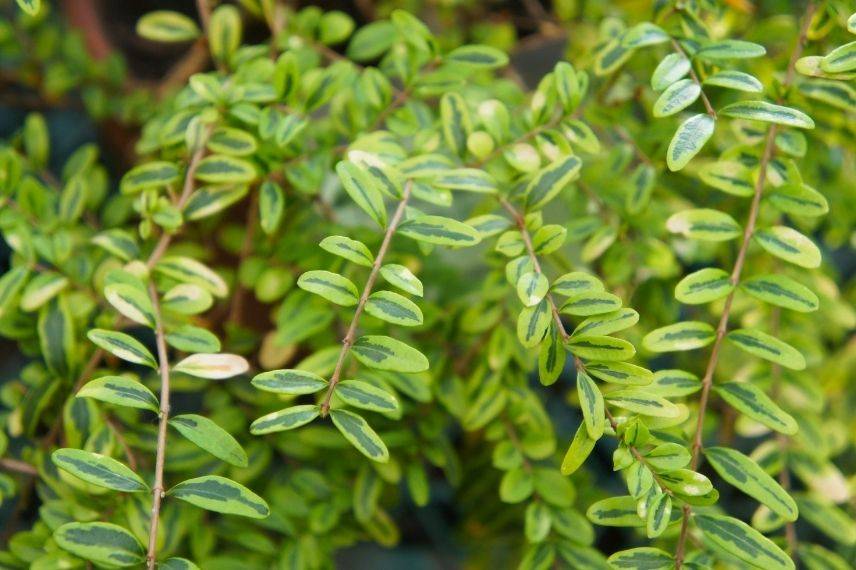
Lonicera nitida ‘Lemon Beauty’
- Subscribe!
- Contents

































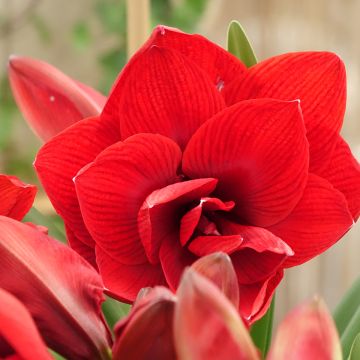



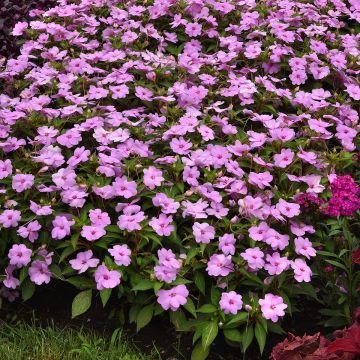
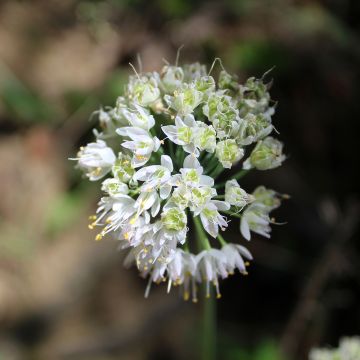
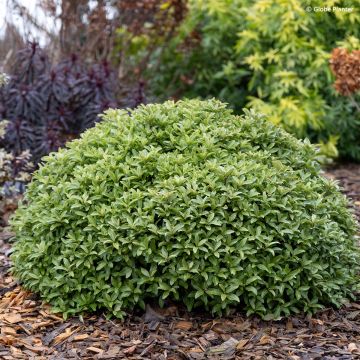
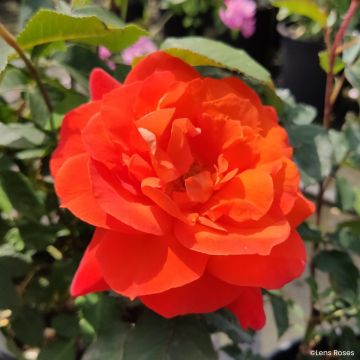

Comments